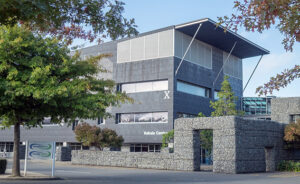The Taonga Māori and Me Ngā Kupu Tuku Iho Projects, funded by the Ara Foundation are quite possibly some of the more important pieces of work that we have been involved with. The projects have as their purpose the need to discover, capture, explore and archive the artefacts, and their narratives, of Madras Campus, with a focus on Te Puna Wānaka.
With the merging of Ara with Te Pūkenga the need arose to ensure all artefacts including pou, values and narratives from Ara kaupapa Māori were retained for future generations of ākonga and kaiako. The project was split into two phases with the first phase being to document the taonga Māori on the Madras campus.
These taonga can now be explored using the Ngā Taonga Māori O Ara App that enables easy access to the rich history and teachings of taonga and Maturanga Māori at Ara. The app was created by Ara Kaimahi, Dr Bernard Otinpong and Dr Dipendra Ghimire, along with ākonga Jacob Klemick from the Department of Creative Arts and Digital Information. All information is now stored in one place that is accessible to everyone. Users can take a self-guided tour of the Madras Street campus and Te Puna Wānaka in either Te Reo Māori or English, accessing it via spoken or written word.
The app has been available since early 2024 and you can access it here – android and i0S users
According to Harry Westrupp, Kaumatua Poutama and Te Waha Pu, Te Puna Wānaka had lost some of their stories over their 25-year history and wanted to ensure that they not only regathered that korero but that it was recorded for the future.
Phase One of the project was completed by the end of 2023 and included not just the gathering of taonga but also the translation of those stories from English to te reo Māori. For example, each of the pou within Te Puna Wānaka has now been documented and its story told alongside some of the other artefacts. In the same manner, the names of each of the buildings on campus have also been documented with their story told in te reo Māori and English.
“This has been an amazing exercise providing much greater depth of knowledge about the history of the pou and how taonga have come into our collection. We have appreciated Ara Foundation funding to produce this wonderful resource that will be available for future generations. Without this funding we would have lost the origin and narratives of many of our treasures but now we know they are safe,” says Harry.
Phase two of the project was also funded by Ara Foundation and includes the extension of the work to other campuses across Te Waipounamu including Woolston, Timaru, Ashburton, Oamaru and Manawa.
To give you a taste of what is available on the app and in the archives, here are two stories of some of the taonga on offer.
Tukutuku – Nā MIT – Nā Toby Rikihana i tuku (Te Mātauranga Māori, 1995)
He kōrero mō ngā tini manu ka rere nei i te ao ki te kimi mātauranga. Kei runga i te manu ko Ngā Kete o te Wānanga. Ko ngā Paua kei raro i te manu ko te moana o Manukau. Te Ika a Maui me Te Waipounamu.

This narrative represents the various birds that fly across the skies in search of knowledge. Above the bird are the baskets of knowledge. The Paua beneath the bird is the Manukau harbour as well as the North and South Islands.
The stories behind the naming of each building on the Madras campus have also been told.
Rakaia Centre
Nei te whakamānawa ki te pokapū o te oranga o Rakaia. Koia tēnei ko te wai honohono ki ngā awa tipua o te rohe nei o Waitaha. Kei te tonga o Ōtautahi tēnei awa rangatira, ā, ko ōna kōrero he tuku iho mai rā anō. Ko tētahi kōrero ko te tikanga o te kupu ‘Raka(ia)’ ko te raka he tuitui kia kotahi pēnei me te aho. Ka mutu ko ngā tipuna nā rātou te awa nei i whakawhitia mā te Rakaia ā ringa me te whakawhiti tahi e ora ai rātou. Tērā anō ngā kōrero mō tētahi Kahikatea e tata ana ki te Rakaia ko Hine Paaka te ingoa. Hei tā ētahi kōrero ko te wāhi tēnei i tau ai ngā iwi o te tonga, ā, moe ai i mua i te haeretanga atu ki Kaiapoi.

The heart of the institution and Polytechnic life is the Rakaia Centre. This is the water that joins all the esteemed rivers of Waitaha. This significant river is south of Ōtautahi and rich in narrative. One of the meanings refers to the word ‘Raka(ia)’ meaning to bind together like a strong rope which is a technique used by our ancestors when crossing the Rakaia River. Another meaning refers to a kahikatea, white pine close to the Rakaia which was named Hine Paaka. It was used to signal to the people living south of the Rakaia that they are close to Kaiapoi.